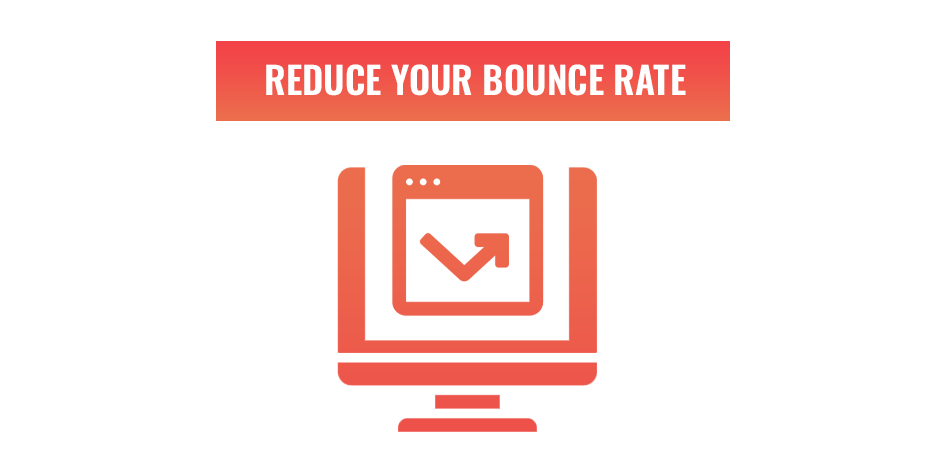
5 ways to reduce bounce rate
When a website is struggling to convert sales, signups or anything else, it’s possible that you will need to take measures to reduce your bounce rate. A high bounce rate can be detrimental to your brand’s online success as it is one of the most common conversions killers.
When your website is not performing as well as it should, it is important to discover why and then implement solutions to solve that. As one of the most common problems, bounce rate seriously hurts your business website’s conversions which in turn, hurts your online success.
Fortunately, there is something you can do about it. In this article, we will dive into what bounce rate is and the things we can do to reduce it on your website.
What is bounce rate?
When someone leaves your website after landing on it, without navigating to another page, we call that a bounce. The bounce rate is the percentage of people who have done that on your website. So, a high bounce rate indicates that someone who landed on your website and had the potential to convert, left.
What makes bounce rate an unreliable statistic is that this will include clicking on a link to a different website, clicking the back button, closing the tab, typing in a URL and session time outs. These are all very normal behaviours on the internet and don’t always mean that there is something wrong with your website.
If your business website has a blog that you link on your social media, a reader could read your whole post and love it, but if they close the tab, it counts as a bounce. So when judging the success of your website, it is important to look at more than one metric.
This doesn’t mean we can forget about bounce rate. It is still important to consider as it can be the result of a serious problem and a low bounce rate is definitely a sign of success.
The good bounce rate to keep and bad bounce rate to reduce.
What is a good bounce rate and what is a bad bounce rate? Well, the answer is not simple but there is a general rule. Every website has its own goals and needs to be looked at differently. The content and purpose of your website play a high factor in this.
That said, here is a good list to use to judge a website’s bounce rate by:
- 80% and above – very bad.
- 70% to 80% – poor.
- 50% to 70% – average.
- 30% to 50% – excellent.
- 20% and below – a sign of a tracking error.
How to reduce your bounce rate.
If your bounce rate is in the 70% and above category, it is too high and you need to reduce it. If your bounce rate is below that, then it is important to stay on top of it. You might even have a low rate and want to optimise it. Whatever situation your website is in, here are five ways to reduce your bounce rate.
Speed up your websites load time.
It can be easy to assume that a high bounce rate is caused by the content, but the problem can start before your client has even seen your website. Slow loading landing pages are killers when it comes to bounce rate.
Most of your clients and readers will not want to wait any longer than three seconds to load. Some might even get frustrated after two seconds. This frustration will lead to them bouncing. So, the slower your page loads, the higher your bounce rate will be.
Before you look look at content being the cause for high bounce rates, look at the loading speed on your landing pages.
Google also looks at your website speed for search engine results page (SERP) ranking. If you want to find out more about that, read our article about tricks that you can use for better SEO.
Strong, readable and engaging content.
If a client can’t read your website, they won’t know what to do other than bounce. Your content needs to be easy to read and navigate for a low bounce rate especially if your content has a lot to say.
Pay close attention to how people read content on a website. They scan a page to look for something that stands out. This could be a heading, word or image. Large groups of plain text can slow this behaviour down. In some cases, this may be the desired result, like when you want your client to make a very serious decision. However, your landing pages should not be doing this.
Format your content for easy reading.
The less effort someone has to out in to get what they want from your website, the better. They are more likely to stay and continue navigating your website if it feels effortless. This is were formatting comes in.
To avoid overwhelming your clients when they land on your website, consider these formatting tips:
- Use headers appropriately so that a client knows where they are.
- Use subheadings frequently to break up content.
- Keep paragraphs short in both length and width.
- Use images that fit the content and amuse the reader.
- Break up steps with easy to read bullet points.
- Use white space.
Make powerful Calls to Action.
When a client lands, it is important for them to know what to do next and a weak call to action (CTA) can lose a lot of attention on your website. To begin with creating a strong CTA, consider what you want your clients to do on the landing page. With that goal in mind, craft one clear CTA. More than one will overwhelm your clients and distract from your message.
A well made CTA will effortlessly guide your clients to take the steps into getting what they want and what you want them to do.
Improve the user experience.
The user experience (UX) is a multifaceted part of reducing bounce rate. It’s a topic that is ever-changing and can take multiple articles to cover. For the purpose of bounce rate, we are going to discuss two things; popups and sidebars. If you want to find out more about improving your website’s UX, read our article about it.
Using and reducing popups.
Most people will always hate popups, especially ones that are irrelevant. They are distracting and will lead to bad UX. Some popups are well designed and convert clients into email subscribers or visitors into readers. This is why getting rid of popups if you already use them is not the immediate answer. What is important is to make them unobtrusive and less frustrating.
Free up the sidebar.
While sidebars might seem like “it’s free real estate” it’s not necessarily so. It can be easy to cram widgets, promotions, awards and ads in there, but this will cramp your website and chase away your clients.
What a sidebar is great for is displaying relevant, but minimal, information that expands on what your client is busy looking at on the page. This can include a related promotion or awards that come from well-known sources. Whatever it is you decide to put there, keep it minimal, relevant.
Aim for the right keywords.
Your content should be search engine optimised (SEO) for the best results, but it needs to be optimised for the relevant keywords. If your landing page is ranking for a search that it doesn’t answer, clients will bounce. If your Google Ads shows up on a search that it doesn’t supply an answer to, clients will bounce.
You want to show up on searches that your landing page answers and can promise additional information for. This isn’t the first bounce rate advice that will be about relevance and it will not be your last should you do additional research.
Keep your keywords relevant to the search queries you expect and your bounce rate will not increase because of irrelevance from a search result.
Have your business website set up for success with Web2Web.
What’s better than advice to reduce your website’s bounce rate? Having a website built or updated to succeed from the start. When you work with Web2Web for your brand’s website needs, you will get a team of designers and developers that take every UX and SEO metric into consideration. If you want your business to succeed online, contact us and we can discuss how to move your brand forward online.

 021 551 2060
021 551 2060



